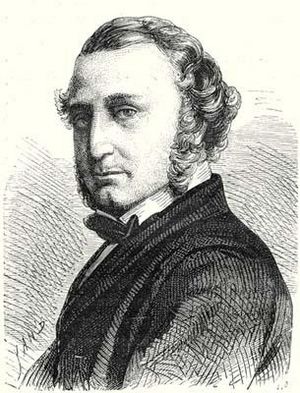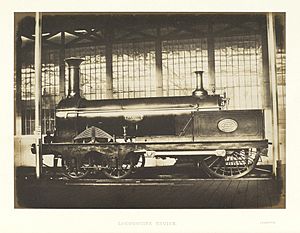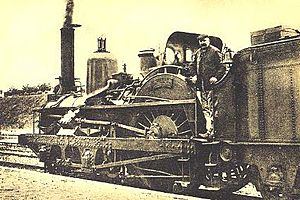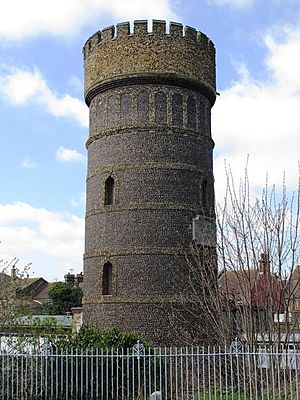Thomas Russell Crampton facts for kids
Quick facts for kids
Thomas Russell Crampton
MICE, MIMechE
|
|
|---|---|
 |
|
| Born | 6 August 1816 Broadstairs, Thanet, Kent
|
| Died | 19 April 1888 (aged 71) |
| Occupation | Railway Engineer |
Thomas Russell Crampton (born August 6, 1816 – died April 19, 1888) was a clever English engineer. He was born in Broadstairs, Kent. He learned his engineering skills while working on Brunel's Great Western Railway.
Crampton is most famous for creating a special type of train called the Crampton locomotive. But he was interested in many other engineering projects too! He worked on the electric telegraph and even designed a digging machine for the Channel Tunnel. His train designs were very popular and successful in countries like France, Germany, and Italy, even more so than in the UK.
Thomas Crampton's Life Story
Thomas Crampton was born on August 6, 1816, in Broadstairs. His parents were John and Mary Crampton. His father was a plumber and an architect. Thomas went to a private school.
On February 25, 1841, Crampton married Louisa Martha Hall. She was a singer and a friend of the famous singer Jenny Lind. Thomas and Louisa had eight children, six boys and two girls. Sadly, their oldest daughter, Ada Sarah, passed away when she was only four years old. Crampton gave a beautiful stained glass window to St. Peter's church in Broadstairs to remember her. Their youngest daughter, Louisa, later married Sir Horace Rumbold, who was an ambassador.
Thomas Crampton died at his home in Westminster on April 19, 1888. He was buried in Kensal Green Cemetery.
Thomas Crampton's Engineering Career
Crampton started his engineering journey working with Marc Brunel. Later, he joined the Great Western Railway (GWR) in Swindon.
Working at Great Western Railway (1839-1843)
From 1839, Crampton worked as an assistant to Daniel Gooch at the GWR. He helped design the ""Firefly" class" of locomotives. Gooch wanted to build broad gauge trains that were better than those on standard gauge tracks. This would show that the broad gauge system was technically superior.
However, Crampton had his own secret idea. He wanted to make standard gauge locomotives so good that they could match the broad gauge ones. In 1843, he left the GWR to pursue his own designs.
Developing New Locomotives (1844-1851)
Crampton understood why GWR's broad gauge trains were so good. They had larger boilers and bigger fireboxes, which helped them make more power. They also had larger driving wheels, which allowed for higher speeds.
In 1843, Crampton got a patent for his new train design. His Crampton locomotives looked unique because their driving wheels were placed behind the firebox. But he also made important technical improvements. These included wider steam passages, large heating surfaces, and strong wheel bearings. These ideas helped shape how trains would be designed in the future.
From 1844 to 1848, Crampton worked for John and George Rennie.
In 1845, Crampton received his first order for a train based on his patent. A railway in Belgium ordered three locomotives. These trains were built by Tulk and Ley. One of them was tested in 1847 on the London and North Western Railway (LNWR). The LNWR was so impressed that they built their own "Crampton Patent" locomotive. They even bought two more, including a powerful train called Liverpool in 1848. This train was said to reach speeds of 79 miles per hour!
In 1847, Crampton helped start the Institution of Mechanical Engineers. In 1848, he opened his own Civil Engineering business in London. In 1851, Crampton also started the Broadstairs Gasworks, helping to build and pay for it.
Working with the South Eastern Railway (1851-1888)

By 1851, Crampton was working for the South Eastern Railway (SER). That year, ten new Crampton locomotives were built. One of them, No. 136 Folkstone, was shown at The Great Exhibition.
In 1854, Crampton became a member of the Institution of Civil Engineers. In 1855, he was in charge of building the waterworks in Berlin, Germany. The King of Prussia even gave him an award in 1856!
In 1859, Crampton started the Broadstairs Water Company. He built a tall water tower, which is now the Crampton Tower Museum. This tower could hold a huge amount of water. He also helped design a tower for Holy Trinity church in Broadstairs and gave a clock to the church. He also donated a wrought iron bridge, named Louisa Gap bridge after his youngest daughter. In 1883, Crampton became a vice-president of the Institution of Mechanical Engineers.
Partnership and Railway Lines
Crampton joined a business partnership with Sir Morton Peto and Edward Betts to build part of the London Chatham and Dover Railway. When the partnership ran into financial trouble in 1867, Crampton faced bankruptcy. However, unlike his partners, he managed to keep his good reputation and continue his work.
Crampton was involved in building several railway lines. These included lines between Smyrna and Aidin, and Varna and Rustchuk. He also worked on lines for the London, Chatham and Dover Railway in England. He was also a partner in the Mont Cenis Pass Railway.
The Electric Telegraph
Crampton was responsible for laying the world's first international underwater cable! This cable was placed in the Strait of Dover in 1851. It allowed messages to be sent between England and France. The first messages were sent on November 13, 1851. This cable was used until 1859.
Crampton was the engineer for this important project. Messages could travel from Paris to London by using the SER's wires, which relayed them from Dover.
Designing for the Channel Tunnel
Crampton designed a special machine for digging tunnels. It was an automatic machine that used water power. This invention was meant to be used for building the Channel Tunnel. His ideas helped make modern drilling techniques possible.
Images for kids
See also
 In Spanish: Thomas Russell Crampton para niños
In Spanish: Thomas Russell Crampton para niños




